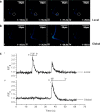Light-induced Ca(2+) transients observed in widefield epi-fluorescence microscopy of excitable cells
- PMID: 22741073
- PMCID: PMC3370967
- DOI: 10.1364/BOE.3.001266
Light-induced Ca(2+) transients observed in widefield epi-fluorescence microscopy of excitable cells
Abstract
We have investigated the possibility that variations in the level of intracellular Ca(2+) in excitable cells might be induced as an artifact of the incoherent illumination that is being used to monitor transient responses. In order to avoid the fluctuations in power of an arc lamp source, a microscope using a light emitting diode that was calibrated accurately at low power levels, was constructed to provide good control over the dose of light applied to the biological specimen. We report here that higher powers of illumination increased the probability of occurrence of Ca(2+) transients even in the sub-mW range normally used to measure such transients in epi-fluorescence work, suggesting that caution should be exercised when designing experiments and interpreting data.
Keywords: (170.0110) Imaging systems; (170.2520) Fluorescence microscopy; (170.3880) Medical and biological imaging; (170.5380) Physiology.
Figures





Similar articles
-
Fluorescence microscope light source stability.Histochem Cell Biol. 2019 Apr;151(4):357-366. doi: 10.1007/s00418-019-01776-6. Epub 2019 Feb 14. Histochem Cell Biol. 2019. PMID: 30767050
-
LED arrays as cost effective and efficient light sources for widefield microscopy.PLoS One. 2008 May 14;3(5):e2146. doi: 10.1371/journal.pone.0002146. PLoS One. 2008. PMID: 18478056 Free PMC article.
-
Artifact-free objective-type multicolor total internal reflection fluorescence microscopy with light-emitting diode light sources-Part I.J Biophotonics. 2019 Nov;12(11):e201900033. doi: 10.1002/jbio.201900033. Epub 2019 Jul 23. J Biophotonics. 2019. PMID: 31148410
-
Widefield fluorescence microscopy with extended resolution.Histochem Cell Biol. 2008 Nov;130(5):807-17. doi: 10.1007/s00418-008-0506-8. Epub 2008 Sep 23. Histochem Cell Biol. 2008. PMID: 18810482 Review.
-
Light-emitting diodes in modern microscopy--from David to Goliath?Cytometry A. 2012 Mar;81(3):188-97. doi: 10.1002/cyto.a.22023. Epub 2012 Jan 30. Cytometry A. 2012. PMID: 22290727 Review.
Cited by
-
Biological effects and medical applications of infrared radiation.J Photochem Photobiol B. 2017 May;170:197-207. doi: 10.1016/j.jphotobiol.2017.04.014. Epub 2017 Apr 13. J Photochem Photobiol B. 2017. PMID: 28441605 Free PMC article. Review.
-
Between life and death: strategies to reduce phototoxicity in super-resolution microscopy.J Phys D Appl Phys. 2020 Apr 15;53(16):163001. doi: 10.1088/1361-6463/ab6b95. Epub 2020 Feb 14. J Phys D Appl Phys. 2020. PMID: 33994582 Free PMC article. Review.
-
A 340/380 nm light-emitting diode illuminator for Fura-2 AM ratiometric Ca2+ imaging of live cells with better than 5 nM precision.J Microsc. 2018 Mar;269(3):212-220. doi: 10.1111/jmi.12616. Epub 2017 Aug 24. J Microsc. 2018. PMID: 28837217 Free PMC article.
-
Widefield Two-Photon Excitation without Scanning: Live Cell Microscopy with High Time Resolution and Low Photo-Bleaching.PLoS One. 2016 Jan 29;11(1):e0147115. doi: 10.1371/journal.pone.0147115. eCollection 2016. PLoS One. 2016. PMID: 26824845 Free PMC article.
-
Harnessing artificial intelligence to reduce phototoxicity in live imaging.J Cell Sci. 2024 Feb 1;137(3):jcs261545. doi: 10.1242/jcs.261545. Epub 2024 Feb 7. J Cell Sci. 2024. PMID: 38324353 Free PMC article.
References
LinkOut - more resources
Full Text Sources
Miscellaneous
